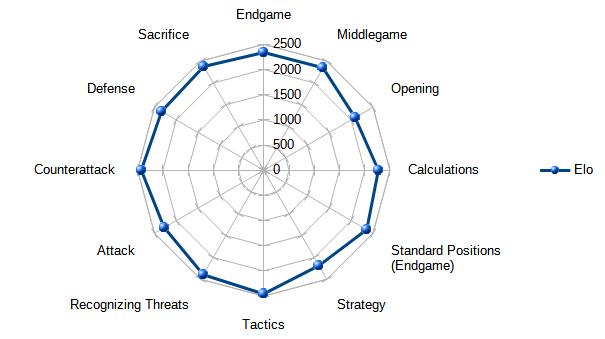
Khmelnitsky test: performing the
test requires some attention, as the score displayed using the 'info' key,
after interrupting the search, is sometimes inappropriate. I use the
infinite level (B8) and I stop the search exactly after three minutes
thinking time (or one minute in some situations); and sometimes the
score is then re-computed on the fly, leveraging a single ply, instant
search. It is thus mandatory to enable the display evaluation option
while the computer is thinking, and to use the value that was displayed just before stopping the search.
As expected, the Mephisto Chess Challenger's
profile is close to the one of the GK2000 from the same
author, powered by the same processor; except for roughly
hundred more points (the 32Kb ROM enabled the program to be enhanced,
compared to only 16Kb for the GK2000). The main strengths remain
tactics, recognizing threats, and counterattacks. Nothing better as far
as endgame is concerned, on another hand the algorithms have been
significantly reworked in order to strengthen the middlegame play. The Chess Challenger is particularly
comfortable in intricate positions actually featuring a lot
of pieces, where its tactical skills rule. In return, still
comparing to the GK2000, the level of play in the opening lowered
noticeably
(meaning playing out of book, when most pieces are present but
not still whith much complex tactics). A human player at same average
level can leverage significantly better attacking skills, but would
wisely keep the game simple and play cautiously until the endgame is
reached.
As a conclusion, I point out the H8 bug affected the
test in 4 out of 100 positions.

 Year: 2004
Year: 2004
 Year: 2004
Year: 2004


 Year: 2004
Year: 2004


 Year: 1992
Year: 1992

 Year: 2016
(prototype), 2021 (this device)
Year: 2016
(prototype), 2021 (this device)

 Year: 2016
Year: 2016

 Year: 2023
Year: 2023



 Year: 2019
Year: 2019


 Year:
2019
Year:
2019